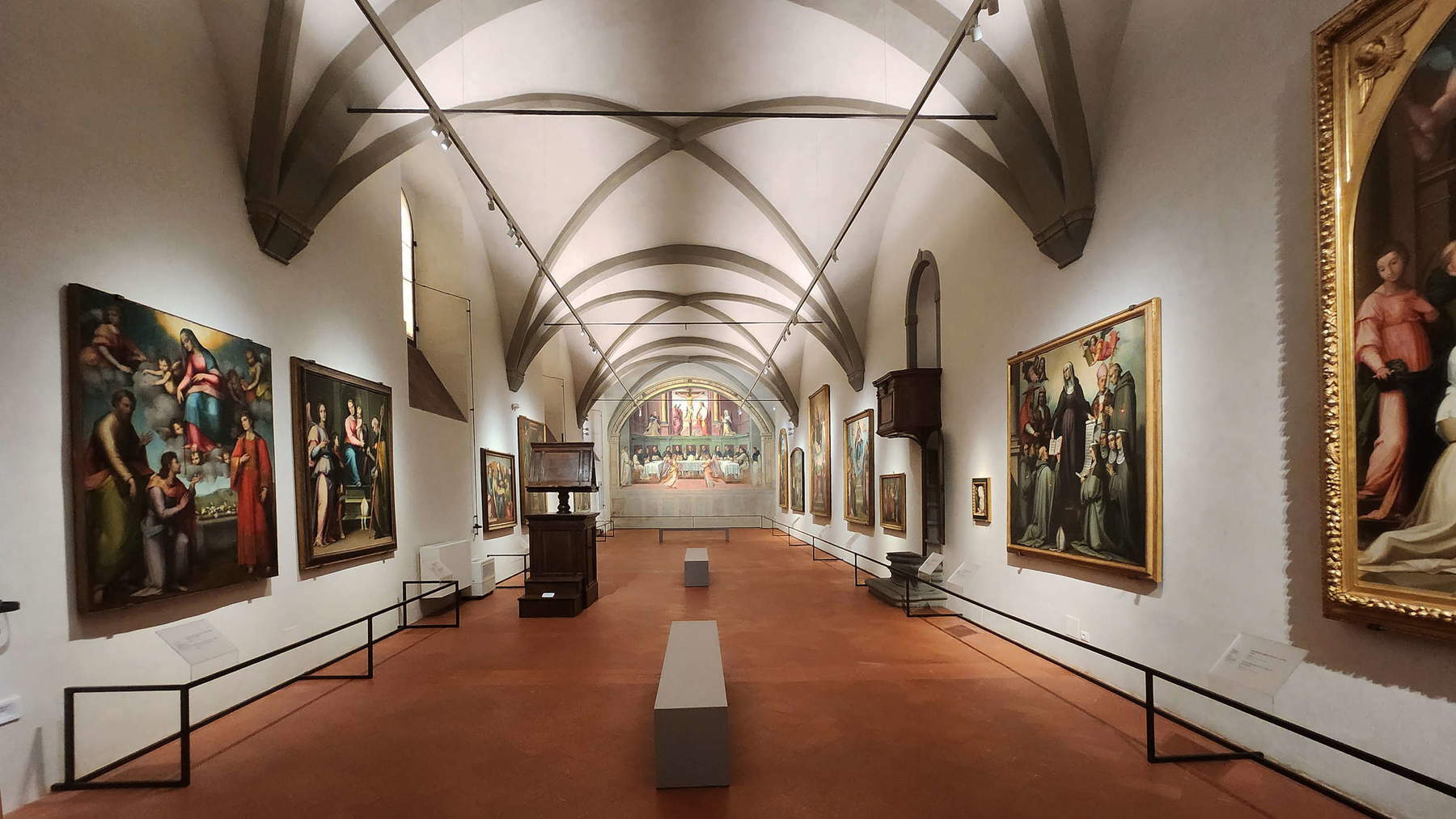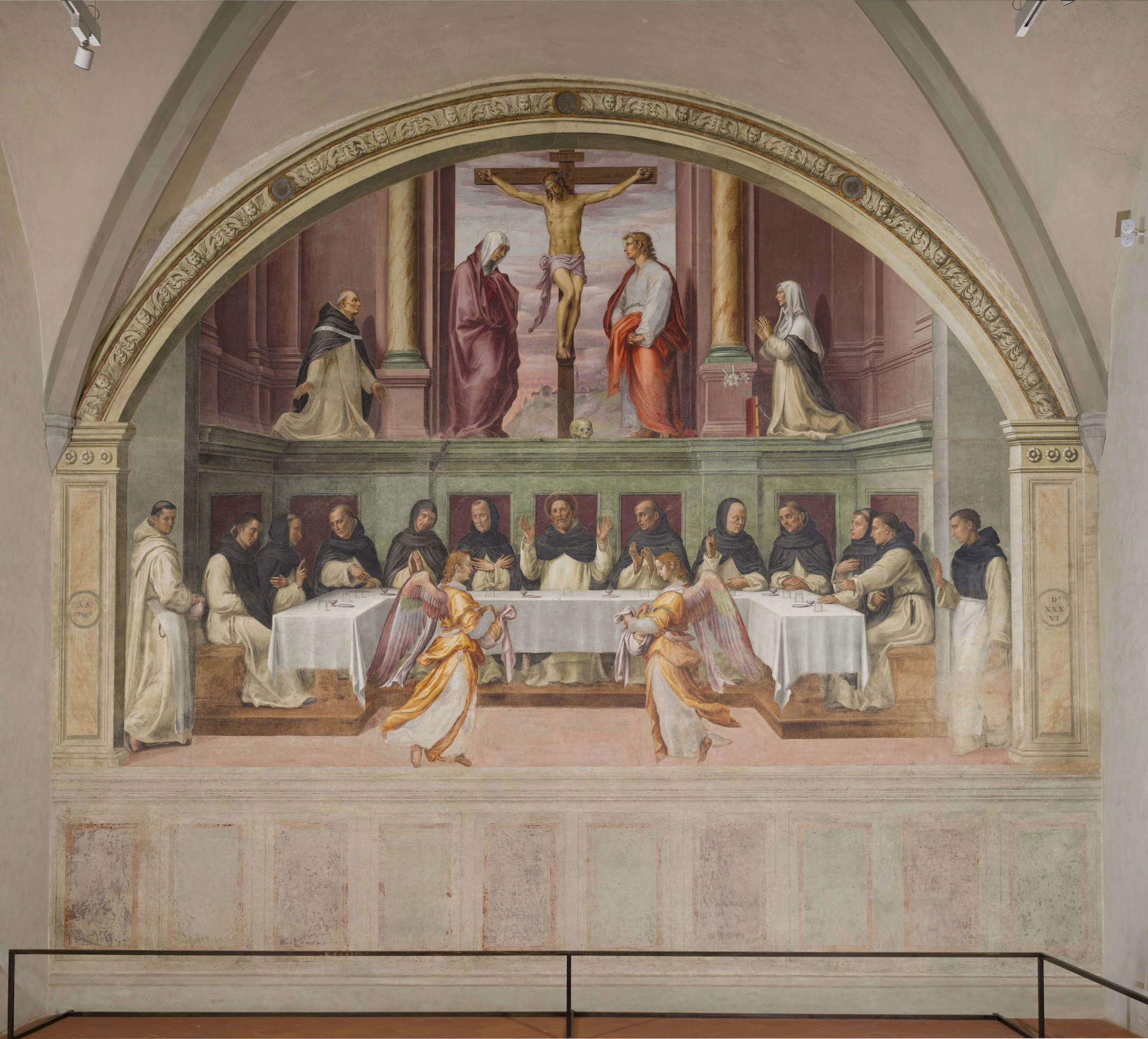In Florence, the Museo di San Marco reopens to visitors the Refettorio grande, completely restored and refitted after a long period of closure that began in October 2023. The room, which was inaccessible due to the lifting of the terracotta floor, is now once again available to the public along with the other areas of the museum, including the Sala del Beato Angelico and the Refettorio piccolo, known for Ghirlandaio’s large fresco. The intervention involved not only the floor but also the 1536 fresco by Giovanni Antonio Sogliani, which depicts the Providence of the Dominicans surmounted by a Crucifixion. This work, already restored in the 1970s, needed further restoration.
The restoration was made possible by a donation from Michael W. Scherb and a public-private agreement aimed at enhancing Florence’s cultural heritage. The Regional Museums Directorate of Tuscany led the work, which restored the integrity of the floor, recovered the spatiality of the room, and enhanced the works of art with new lighting and a modern museum layout.
Among the main changes, the old paneling system, which limited the perception of the original architecture, was removed, allowing a new arrangement of the paintings directly on the walls. The lighting system, now composed of LED spotlights, ensures optimal visibility for both the works and the Gothic architecture of the Refectory. In addition to significant energy savings, the new lights create a more comfortable environment for visitors. In line with the intent to rediscover and enhance the historic architecture, the gray hue of the vault ribs, consistent with the previous coloring identified during the essays, was reintroduced. Display support elements, such as captions and spacers, have been standardized with the design of the Museum’s other rooms, creating continuity in the visit path.
Historically, the Great Refectory was the place where the friars ate community meals. Characterized by Gothic architecture, the room was later enlarged by Michelozzo for the Medici. Today it houses important 16th-century paintings related to the School of St. Mark, which looked to the classical and devotional painting of Friar Bartholomew, and a 17th-century wooden pulpit. Sogliani’s fresco dominates the head wall of the Refectory and depicts an episode in which the Angels provide food for the Dominican friars left without provisions, in an alternative to the traditional Last Supper theme. The painstaking restoration has breathed life back into the details of the work, which are now legible again, such as the angels’ multicolored wings and the reflections in the glasses.
The recovery of the fresco, supplemented by advanced chemical-physical and diagnostic investigations, has also allowed the rediscovery of the painted faux-marble base, finally visible after having been long hidden by the wooden benches. The Great Refectory is thus once again one of the highlights of the St. Mark’s Museum, ready to welcome visitors. The fresco, moreover, had already undergone restoration work in the 1970s, necessary following the extensive damage caused by the November 1966 flood.
The thorough diagnostic campaign prior to the restoration provided fundamental data for understanding the fresco’s state of conservation and establishing priorities for intervention. Thanks to a series of sophisticated investigations-including visible and grazing light photography, ultraviolet fluorescence, thermographic and chemical-physical investigations-the need for extensive cleaning and consolidation work emerged. These works restored the fresco to its original legibility, allowing details previously hidden or compromised to be appreciated again. Particularly relevant was the recovery of the base of the fresco, previously hidden by irrelevant wooden benches that had obscured its vision. Thanks to the restoration, the painted faux marble mirrors, which had been severely damaged in the past, were also restored, restoring the work to its chromatic integrity and allowing full enjoyment of its aesthetic and historical value.


“When a museum space is returned to public enjoyment,” comments Director General Museums, Massimo Osanna, “it is always a moment to celebrate: in this case, if possible, even more so, because it happens thanks to a virtuous practice, defined by a public-private agreement, put in place by the Regional Directorate National Museums Tuscany with the generous donation of patron Michael W. Scherb and his family. This is further evidence of the central role that cultural heritage plays for communities and civil society.”
“I am very grateful to Michael W. Scherb and his family,” says Stefano Casciu, Regional Director National Museums Tuscany of the MiC, “for deciding to support our project of renovation and new museum layout of the Great Refectory of the Museum of San Marco, partially closed to the public since October 2023, a room of great charm, extremely important for the history of the Dominican convent and for the pictorial works present, witnesses of the School of San Marco of the first half of the sixteenth century. With great generosity, Michael accepted our proposal, giving us complete freedom and showing the utmost trust, while showing a constant and attentive interest in the work in progress, with frequent visits and regular contacts during the intervention. For us, our relationship with him has been an ideal example of fruitful public-private collaboration, thanks to which the Museum of San Marco and its public have been able to reappropriate a fundamental space, long denied, but of remarkable importance for Florentine architecture, history and art. A museum space that has its zenith in the splendid fresco by Giovanni Antonio Sogliani, now fully restored, and in the new arrangement of the 16th-century paintings of the Scuola di San Marco, with works by Sogliani himself, Ridolfo del Ghirlandaio, Fra’ Paolino, Mariotto Albertinelli and Suor Plautilla Nelli , enhanced by new lighting and illustrated by new information displays in Italian and English, created in accordance with the unified graphic line that now unites all the museum’s spaces. I am therefore deeply grateful to Michael W. Scherb and his family, who are now fully part of the international community of people who have chosen the St. Mark’s Museum as their place of choice because of its special cultural and spiritual values. I would also like to take this opportunity to thank all the staff members inside and outside our Office who have helped to achieve this splendid result.”
“We are grateful to the Ministry of Culture for offering us the opportunity to support this inspiring restoration,” said Michael W. Scherb. “Each year, we support a different cultural institution around the world, and San Marco represents our third project. We have been fascinated by the history and beauty of the hall, and we are proud that Florentines and art lovers can fully relive it. For a city that has given so much to humanity, it is an honor to return the favor.”
 |
| Florence, San Marco Museum's Grand Refectory reopens, restored and refitted |
Warning: the translation into English of the original Italian article was created using automatic tools. We undertake to review all articles, but we do not guarantee the total absence of inaccuracies in the translation due to the program. You can find the original by clicking on the ITA button. If you find any mistake,please contact us.